- You are here:
- Home »
- Bike Accessories
Category Archives for Bike Accessories

Best Cycling Shoes for Men and Women of 2017
The gear that one uses makes all the difference for those who make a lifestyle choice out of biking. Cardiovascular endurance puts a heavy strain on many parts of the body and, most of all, the feet and legs. The best cycling shoes for men and women of 2017 are designed to protect the rider’s joints and muscles from strain and long-term damage, as well as to enable the most efficient riding.
Cycling Shoe Key Features
Just like cycling shorts, a pair of shoes made for cycling come in many shapes and sizes and are made for indoor, outdoor, or off-trail biking. It is important to take special note of how the shoe feels on your foot as not all cycling shoes are made for all feet—there is no such thing as ‘no one shoe fits all.’ Consider finding a few of the best cycling shoes that you would like to try on and go to your local bike shop to give them a try.
 Once you are ready to settle on one pair that feels good and fits well, save some money by ordering them from our links below. Of the many design aspects present, there are four key features that bikers should take note of when looking at cycling shoes.
Once you are ready to settle on one pair that feels good and fits well, save some money by ordering them from our links below. Of the many design aspects present, there are four key features that bikers should take note of when looking at cycling shoes.
Fasteners
Cycling shoes feature one of four different fastening methods. The most common and inexpensive fasteners are made by Velcro. Velcro can be easy to adjust and lightweight but will lose strength over time with continued rugged use. There are some cycling shoes that feature laces, but these are specialized and can be quite pricey. The highest quality systems include Ratchets and Boa Dials.
The Ratchet system is secure and accurate but it is quite impossible to adjust during a ride. The Boa Dial system is not cheap, but it gives cyclists the best of both worlds, with a lightweight design that is easy to adjust mid-ride and provides the most secure fit.
Soles
Cycling shoes will most often feature a hard sole design, which supports the foot as a whole when hooked into small pedals. The soles are usually constructed out of carbon, plastic, or a combination of both. Carbon fiber is the best quality material for cycling shoe soles, due to its stiff design and lightweight; however, carbon soles are often seen in shoes that sit on the upper end of the price scale.
 Plastic soles are much more affordable; however, their durability and overall quality is not that of longevity. Cycling shoes in the middle of the market range are often constructed of a composite combination of carbon and plastic. Try on several pairs with different sole construction to determine the sole stiffness that feels best for you.
Plastic soles are much more affordable; however, their durability and overall quality is not that of longevity. Cycling shoes in the middle of the market range are often constructed of a composite combination of carbon and plastic. Try on several pairs with different sole construction to determine the sole stiffness that feels best for you.
Cleat Design
Cleats are designed as either 2-bolt SPD clipless cleats or 3-bolt cleats. 3-bolt cleats are sometimes preferred by those whose main form of cycling is indoor spin cycling. They are very secure to the pedals but are not easy to walk in. Clipless cleats with 2 bolts are often preferred by bike commuters and touring cyclists riding outdoors.
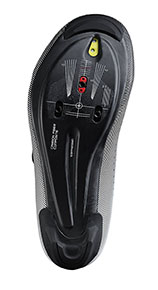 This is because clipless pedals allow the rider to remove their foot from the pedal at any time, simply by swinging their heel away from the bike. 2-bolt SPD cleats are also designed to sit inside of the cycling shoe, making it easy and comfortable to walk in them. Try cycling with both styles before settling on one or the other.
This is because clipless pedals allow the rider to remove their foot from the pedal at any time, simply by swinging their heel away from the bike. 2-bolt SPD cleats are also designed to sit inside of the cycling shoe, making it easy and comfortable to walk in them. Try cycling with both styles before settling on one or the other.
Fit and Comfort
The make and model of cycling shoe that you choose will determine how the shoe fits. Many brands are designed with a different standard for width and snugness of the cycling shoe, which will determine how comfortable it is to ride over the long term.
In general, bikers with narrow feet will be served better by Specialized, Giro, and Fizik, whereas Shimano and Bont design cycling shoes with wider feet in mind. Once again, try before you buy as the fit of your shoe will determine how comfortable it is to ride with.
Best Cycling Shoes of 2017
The market is saturated with biking shoes of all types and wading through the options can be an arduous task. We consider the best cycling shoe for men and women to be one that is not only designed with exceptional quality features but also at an affordable price. Below, you will find our top cycling shoe picks for men and women, in 2017.
Best Cycling Shoes for Men
1. Shimano RC7 Lightweight Road Cycling Shoe
Shimano creates some of the best quality biking gear and hardware available on the market. The SH-RC7 is our pick for the best mid-range cycling shoe for men of 2017. Coming in around $180, these cycling shoes are high quality, yet affordable.
 Description and Features
Description and Features
The SH-RC7 tends to be a bit wider than others made for men with large feet. Designed for road racing and endurance cycling, the SH-RC7 features a carbon composite sole for the most support on the pedals. These shoes are lightweight and fashioned from a perforated synthetic leather blend, which is breathable, strong, and soft.
Shimano designed the SH-RC7 with a Boa IP1 reel strap fastening system, which distributes pressure evenly across the top of a rider’s foot, where other designs may constrict circulation to the foot. The hook and loop fastener strap provides a full range of adjustability, allowing the fit to be customized for a wide range of feet.
This cycling shoe has a stiffness rating of 10 out of 12. The hard sole carbon composite provides a maximum amount of support for a rider’s foot, which results in more power and less wasted effort. The SH-RC7 is designed to accommodate a 3-bolt locking system, which makes it perfect for indoor spinning and outdoor long-distance riding.
Best Cycling Shoes for Women of 2017
2. Sidi Level Carbon Road Cycling Shoe
Sidi has been providing the professional biking industry with top quality equipment and gear since 1960. However, their Level product line is specifically designed for entry-level riders, who are serious about cycling.
Due to the overwhelmingly positive reputation of the brand and a reasonable price tag coming in around $140, the Sidi Level Carbon is our pick for the best cycling shoe for women of 2017.
Description and Features
 The Sidi Level is built with a Millennium carbon sole and a buckle closure system. The buckle is operated by a lever on the top of the shoe, which releases or adds tension.
The Sidi Level is built with a Millennium carbon sole and a buckle closure system. The buckle is operated by a lever on the top of the shoe, which releases or adds tension.
To completely release tension, the rider squeezes both ends of the buckle, which unhooks the fasteners. Sidi’s buckle closure system makes it easy and safe to adjust your cycling shoe tension while in motion.
The Sidi Level provides a substantial step up from the traditional nylon sole. The Sidi Level features a nylon/carbon injected matrix fiber, which lets the shoe retain its structure and rigidity, even through heavy temperature changes. The material is inherently water-repellent and is unaffected by changes in the environment’s humidity. The sole is drilled with a 3-hole cleat design; however, it is completely compatible with most standard clipless and 3-hole cleats, allowing for a maximum level of versatility for outdoor or indoor usage.
The carbon sole works in conjunction with the shoe’s heel cup, which retains its shape through heavy use and prolonged riding. The cup is anatomically designed to keep the rider’s heel from slipping, which provides additional protection in the event of an accident and the Sidi Level includes a spare polyurethane heel pad.
More Options
For those who are looking for a more advanced or even an entry-level shoe, check out our other top cycling shoe picks for 2017.
● Giro Riela R Trail Shoe
● Louis Garneau Multi Air Flex Fitness and Mountain Bike Shoe
● Diadora Trivex Plus II Cycling Shoe
● Pearl Izumi Tri Fly V
Feel free to leave comments and questions and always remember to wear a helmet!

Why You Should Have an Indoor Bike Stand
Summer is almost here and you know what that means—bike weather! That’s right. It’s time to dust off your set of wheels and take to the streets. Of course, you are prepared to acclimatize your buns to the feel of the saddle and you’re not looking forward to how your legs are going to feel in the morning.
Nevertheless, you are determined to really give it your all this year. However, biking does not have to be a fair weather activity. Many avid bikers continue their conditioning all through the winter months by using an indoor stationary bike stand.
So, before you take the cycle out for its first cruise of the season, only to abandon it once again to the depths of the garage while you ice your sore buns for the next week, consider the reasons why you should have an indoor bike stand.
It all comes down to consistency. Riding for fun is great, but the biggest benefits of biking are experienced when you make a concerted effort to change the way in which you commute.
 Biking on a regular basis improves your cardiovascular health, muscle strength, endurance stamina, and overall feeling of wellbeing—not to mention the substantial financial savings that become immediately evident, regarding gasoline expenditure, vehicle maintenance, and extraneous costs for parking and more. Biking is, by far, the most health and cost efficient way of commuting.
Biking on a regular basis improves your cardiovascular health, muscle strength, endurance stamina, and overall feeling of wellbeing—not to mention the substantial financial savings that become immediately evident, regarding gasoline expenditure, vehicle maintenance, and extraneous costs for parking and more. Biking is, by far, the most health and cost efficient way of commuting.
Once you establish a habit of bike commuting, it becomes the part of your day that you look forward to. Your body feels alive and invigorated all through the day and you wake up with the anticipation of an exhilarating commute. There is one catch, however, that becomes one of the biggest deterrents to prospective bike commuters—discomfort.
Consistency is Key
There simply is no substitute for regularity and conditioning. The joy of regular biking is mitigated for those who do not engage in it on an everyday basis. This is because their body never gets into the rhythm of daily physical activity, as well as the soreness that results in the riders physical contact points on the bike. Let’s look at another example, which will illustrate this logic…
No Pain, No Gain
Imagine someone who is taking their first guitar lesson and we can call this person, Jill. Jill is excited to learn how to play guitar and she’s not afraid of hard work and focus, but Jill has never been big on physical discomfort. To Jill’s dismay, one of the first obstacles in studying the guitar is to form calluses on her fingers. Before she does this, it will be very difficult to improve as calluses will form naturally to shield her fingers nerve ending from the acute pressure of the guitar strings.
 Since it hurts her fingers to practice, Jill never gets to actually learn how to play the guitar, because she never got over the physical learning curve. Jill’s teacher gives her a little gizmo to strengthen her hand, which will help to condition the muscles that she will use for playing. After a few weeks of strengthening her hand and finger muscles, she is able to maintain a regular practicing regiment, which results in her fingers becoming calloused and her ability to improve becomes exponentially easier, especially with a stationary bike stand.
Since it hurts her fingers to practice, Jill never gets to actually learn how to play the guitar, because she never got over the physical learning curve. Jill’s teacher gives her a little gizmo to strengthen her hand, which will help to condition the muscles that she will use for playing. After a few weeks of strengthening her hand and finger muscles, she is able to maintain a regular practicing regiment, which results in her fingers becoming calloused and her ability to improve becomes exponentially easier, especially with a stationary bike stand.
There is an exact equivalent for bikers and indoor cycling, in the way in which one’s body acclimates to the pressure points of one’s bike, as well as in the conditioning to be maintained using an indoor bike stand trainer. Even if you can’t take the bike out on the town every day, you can keep up your physical conditioning by using a bicycle trainer stand in the comfort of your own home or at the gym.
Without regularity and consistency, the human body wants to find a natural stasis or neutral mode. This is why enabling your daily routine to accommodate cycle conditioning is essential. By keeping up with your biking, either outdoors or indoors, your body will settle into an active neutral state and will stay in a place of readiness from day to day, instead of losing the progress which you have made with indoor cycling.
Why You Should Have an Indoor Bike Stand
 Indoor bike stands, or bicycle trainers, are an essential piece of gear for the serious biker or cardio enthusiast. No matter your daily routine, a bike trainer allows cyclists to use their trainers in their homes, office, school, local gym, or anywhere else that has just enough space to fit their bike.
Indoor bike stands, or bicycle trainers, are an essential piece of gear for the serious biker or cardio enthusiast. No matter your daily routine, a bike trainer allows cyclists to use their trainers in their homes, office, school, local gym, or anywhere else that has just enough space to fit their bike.
Bike stand trainers offer many benefits for those looking to improve the quality of their health and biking performance with a concise, convenient method.
Key Benefits
● Maintain a Healthy Routine in Any Weather
No matter which weather has decided to show up, you never have to sacrifice your daily ride due to nature. With an essential bike trainer indoors, bikers are empowered to maintain their physical conditioning without having to purchase extensive amounts of weather specific gear, which can incur ongoing costs to maintain and replace worn out equipment.
An indoor bike trainer is a one-time expense, which can range between $50 and $1500, depending on the features that you require.
● Train on Your Own Wheels
 Unlike a stationary spinning machine or other exercise bike often found in herds at your local gym, a bike trainer allows you to use the same bike that you use on the road.
Unlike a stationary spinning machine or other exercise bike often found in herds at your local gym, a bike trainer allows you to use the same bike that you use on the road.
Indoor bike stands will attach either to the back wheel of your bike or the back drive train—without the wheel. This is a huge plus for bikers who use cycling shoes of a clip-on, or clipless design, as it allows you to train with your own gear and equipment.
● Take Your Trainer on the Go
Indoor bike trainer stands usually weigh between 40 to 60 pounds and come in convenient carrying cases. They are designed to be portable and mobile, many models including a wheeled case to transport them. Even the larger roller trainers and exercise bikes are foldable and designed for wheeled transportation.
● Have Fun with Other Riders Abroad
 Trainers have seen some great innovations recently with the advent of Smart Turbo Trainers. These indoor bike stands are designed with wireless capabilities and remote controlled operations.
Trainers have seen some great innovations recently with the advent of Smart Turbo Trainers. These indoor bike stands are designed with wireless capabilities and remote controlled operations.
By logging into trainer software, such as Zwift, CycleOps, or TrainerRoad, cyclists can link up with other real people from across the globe, to race on a variety of different courses. The smart technology allows the map to communicate with your trainer, automatically shifting the resistance to correspond with the terrain of your virtual route.
Whether you are a new biker or a veteran, an indoor bike stand trainer will accelerate your rate of improvement and overall health. Why you should have an indoor bike stand, has to do with self-betterment and unlocking your optimum potential as a cyclist. Best of all, no helmet is required.
Feel free to leave comments and questions and thanks for reading!

Benefits of Using Clipless Pedals
For every type of bicycle usage such as a mountain bike or a road bike, there is an optimal pedal system. Pedal systems are divided into three umbrella categories, which are: Flat pedals, clip-on pedals, and clipless pedals. Clipless pedals have become increasingly popular in the last ten years, due to a concerted research and development effort on the part of manufacturers, to innovate and improve how bikers ride.
As bikers, we get to take advantage of the new and improved hardware, created by a competitive market demand, and, for those, looking for a concise and consistent way to better their ride, the benefits of using clipless pedals are easily seen.
The Clipless Bicycle Pedal
A clipless bike pedal does, in fact, use a “clip.” If the pedal was called, an “easy-release pedal,” it might make more sense. “Clipless” refers to the design of a clip-on bike pedal, which predates that of the clipless system.
Clipless System Impetus
Before the clipless system for shoes was conceived, the clip-on pedal system was the standard amongst avid bikers and professionals and is still in use today. This pedal system had several downfalls, as did some preliminary innovations on it, which eventually led to the advent of the modern clipless pedal design.
The clip-on system utilizes a “cage” that is attached to the bike pedal and surrounds a rider’s toe or forefoot, either with a tight hard shell or with an adjustable strap. One downfall of this system was seen in off-roading when a rider’s foot rattled and bounced inside the toe cage, reducing effort efficiency.
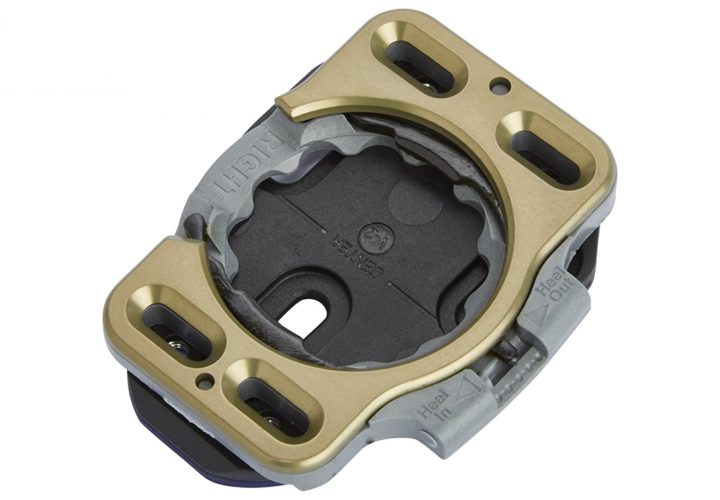 However, the biggest detriment was seen in an accident, when a rider could not remove their feet and shoes from the pedal strap and, as a result, suffered greater injuries. The early predecessor to the modern clipless pedal was first invented as a lever system. A rider had to physically release a pedal lever by hand, which, in a crash, was nearly impossible to accomplish and earned it a deathly reputation among bikers.
However, the biggest detriment was seen in an accident, when a rider could not remove their feet and shoes from the pedal strap and, as a result, suffered greater injuries. The early predecessor to the modern clipless pedal was first invented as a lever system. A rider had to physically release a pedal lever by hand, which, in a crash, was nearly impossible to accomplish and earned it a deathly reputation among bikers.
Riders needed a way of connecting their feet firmly to the pedals thus enabling their hamstrings to pull upwards through the pedal stroke as well as a safety feature, allowing a rider to disconnect their feet from the pedal, in an instant. Though it was first conceived in 1895, the clipless pedal did not gain widespread recognition and acceptance until 1985, when Bernard Hinault became the first biker to ever win the Tour de France using a clipless pedal system.
Using a Clipless Bike Pedal
A clipless bike pedal works by implementing a cleat on the ball of the bike shoe’s sole, which locks into a clip located on the bike’s pedals. The clips are adjustable for firmness, but allow the biker’s feet to maneuver freely. To unlock the shoe’s cleat from the pedals bracket clip, a biker only has to swing their heel away from the bike and the spring operated clip unlocks instantaneously.
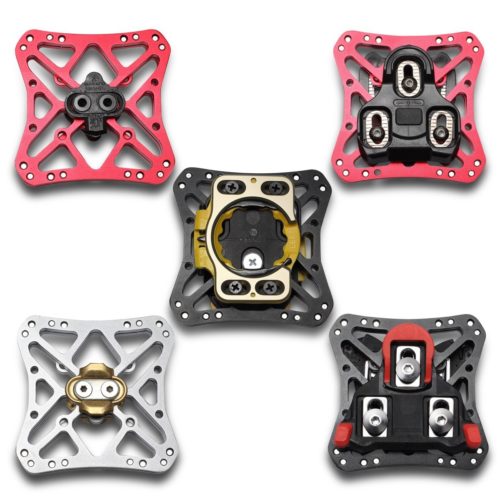 These are called “clipless” since the releasing mechanism is hands-free. However, if it makes you feel better to call them “locking pedals” or “lock and release pedals” feel free. The point is, clipless pedals connect a rider’s feet securely to the bike’s drive train and unlock them from the pedal on command—in an instant. This is why they are the modern standard for bikers everywhere. Once you switch over to clipless pedals, there is no substitution.
These are called “clipless” since the releasing mechanism is hands-free. However, if it makes you feel better to call them “locking pedals” or “lock and release pedals” feel free. The point is, clipless pedals connect a rider’s feet securely to the bike’s drive train and unlock them from the pedal on command—in an instant. This is why they are the modern standard for bikers everywhere. Once you switch over to clipless pedals, there is no substitution.
Benefits of Using Clipless Pedals
Just about every single aspect of your ride will be benefited by using clipless pedals. They are perfect for riders who use their bike as a means of heavy transportation, recreation, or any other type of consistent use. All clipless pedals require a specialized shoe and a compatible cleat, which features a hard sole design, eliminating pressure from the cleat on the ball of the rider’s foot.
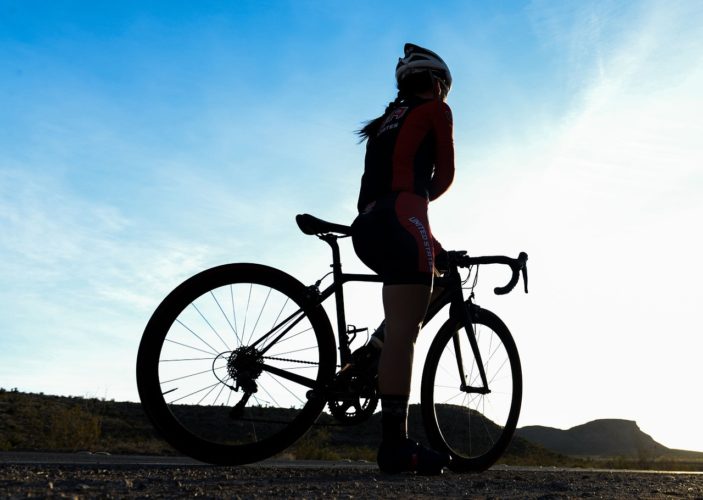 In less than a day, most first-timers have the locking-in and out action in their muscle memory and can do it smoothly, without having to look down. Specifically, the benefits of using clipless pedals are seen in a biker’s improved safety, more efficient effort expenditure, and greater handling power to provide overall greater comfort when for bikers when riding.
In less than a day, most first-timers have the locking-in and out action in their muscle memory and can do it smoothly, without having to look down. Specifically, the benefits of using clipless pedals are seen in a biker’s improved safety, more efficient effort expenditure, and greater handling power to provide overall greater comfort when for bikers when riding.
Safety & Control
If you have ever been out biking in a rainstorm with flat pedals, you know how dangerous it can be to have your feet slipping while riding at speed. Clipless pedals connect your feet firmly with the bike, making it virtually impossible for one’s foot to slide off the pedal, causing a catastrophic incident.
With strap-on pedals, one must physically loosen the strap to release their toe, which is not safe or timely in the event of a sudden stop or unforeseen obstacle. Riders do not have this problem with clipless pedal systems, as the action of unlocking one’s foot from the pedal becomes innate and subconscious to the rider.
The clipless design allows riders to keep their hands on the handlebars at all times. By connecting the feet to the pedal and enabling both hands to remain on the bars, clipless pedals exponentially increase a biker’s handling and control of their vehicle.
Efficiency, Power & Acceleration
Clip-on pedal systems became popular because they allowed riders to use their hamstring on the upward pedal stroke, but the toe-cage and strap design was not efficient for directing force through the drive train. The hard sole shoe design of clipless pedals acts to disperse the force evenly across the top of a rider’s foot on the up stroke, which prevents joint damage and tendon strain.
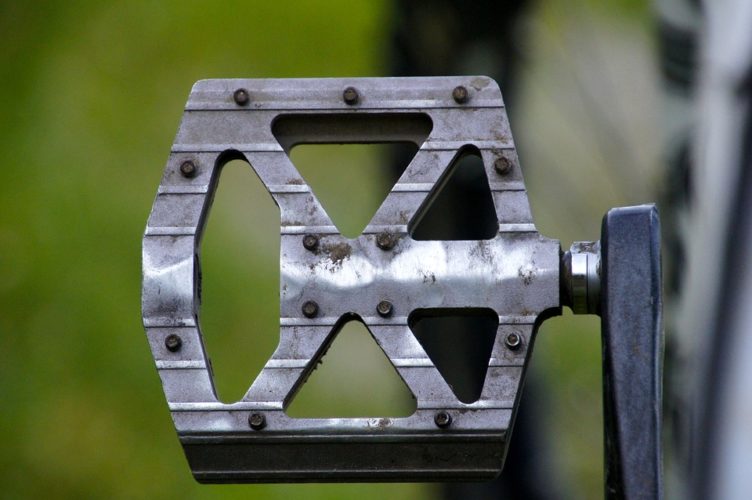 With the classic flat pedal, half of the biker’s potential energy is left dormant, as they are only able to exert a propelling force on the pedals down stroke. By attaching one’s feet to the bike’s pedals, every rotation of the pedals is half as taxing to your body. Since the rider is able to implement strength from more muscle groups, their body is working more efficiently, which results in a nearly exponential increase of acceleration.
With the classic flat pedal, half of the biker’s potential energy is left dormant, as they are only able to exert a propelling force on the pedals down stroke. By attaching one’s feet to the bike’s pedals, every rotation of the pedals is half as taxing to your body. Since the rider is able to implement strength from more muscle groups, their body is working more efficiently, which results in a nearly exponential increase of acceleration.
Confidence & Consistency
Finally, the improved safety, control, power, and efficiency result in greater confidence in one riding, as well as a greater consistency of usage. For example, if your car is on its last legs and every ride might be its last, you don’t exactly wake up looking forward to driving it. On the other hand, if you have a Tesla in the driveway, you probably look forward to driving it.
 When you know that you have outfitted your bike with the right gear including cycling shoes to enable the best ride possible, it becomes a joy and point of pride. The practical and physical benefits of using clipless pedals work to prevent improper body use while riding encourage you to keep up with the consistency of your biking. If you are looking to take your ride to the next level of skill and fun, it is time to experience the benefits of using clipless pedals.
When you know that you have outfitted your bike with the right gear including cycling shoes to enable the best ride possible, it becomes a joy and point of pride. The practical and physical benefits of using clipless pedals work to prevent improper body use while riding encourage you to keep up with the consistency of your biking. If you are looking to take your ride to the next level of skill and fun, it is time to experience the benefits of using clipless pedals.
Feel free to leave comments and question and remember—always wear a helmet!

Why You Should Wear Indoor Cycling Shoes
Biking for fun is great but, once it becomes a regular part of your daily life, it is time to invest in the gear that will enable your best performance in terms of longevity. For those who enjoy indoor spinning or cycle training, improper footwear can cause short-term discomfort and long-term physical repercussions on your muscles, joints, and tendons.
For this reason, serious cyclists choose to use indoor cycling shoes for their training. If you are not fully aware of the reasons why you should wear indoor cycling shoes when training, this guide will serve to outline the major benefits and features of indoor cycling footwear.
Indoor vs. Outdoor Cycling
There are several significant differences between indoor cycling and outdoor cycling that determine the features that are required for their gear. When it comes to a cyclist’s footwear, the right shoes make a substantial difference in the ease, efficiency, and consistency of your ride. Before we get into the specific features and benefits of indoor cycling, let’s outline the key differences between the two styles of riding.
Outdoor Cycling
Ideally, for most bikers, time is spent riding in the beautiful outdoors. After all, the greatest benefit of biking regularly is the bond that is formed between the ground and your body, as you ride the waves of the landscape. The footwear that a rider chooses will depend completely on the type of outdoor riding that they engage in.
 Trail riding and mountain biking will require a very different style of cycling shoe than that of urban commuters and road cyclists. The cycling shoe that you use outdoors must be designed to withstand environmental factors, such as rain, debris, and temperature fluctuations. Also, riding on the road or trail requires an ability to dismount the bike for many reasons, such as accidents and stop lights.
Trail riding and mountain biking will require a very different style of cycling shoe than that of urban commuters and road cyclists. The cycling shoe that you use outdoors must be designed to withstand environmental factors, such as rain, debris, and temperature fluctuations. Also, riding on the road or trail requires an ability to dismount the bike for many reasons, such as accidents and stop lights.
Many outdoor cycling shoes are clipless (cleats) or have some sort of strap-in feature that is easily disconnected by the rider’s feet. Cycling shoes, for outdoor riding, will usually feature a specialized cleat and pedal system, which does not inhibit one’s ability to walk normally in the shoe. Some road cycling and racing shoes will be acceptable for indoor uses, but indoor cycling shoes are not generally intended for outdoor use.
Indoor Cycling
Indoor cycling has gained popularity in recent years, mostly in the form of spin classes. The most obvious, and definitive difference between outdoor and indoor cycling, is movement. When cycling indoors, the rider is completely stationary the entire time, which has a significant impact on the design of footwear intended solely for indoor use. Though they offer less overall versatility, indoor cycling shoes are generally priced around $100, as opposed to their multi-hundred dollar outdoor counterparts.
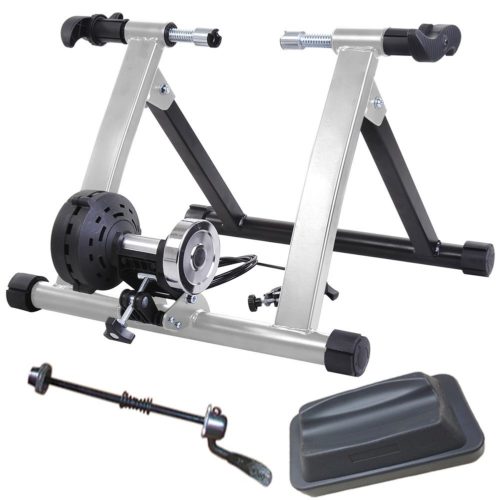 Indoor cycling, or spinning, either uses a spin cycle machine or a cycling turbo trainer, which connects to the rear wheel of the cyclist’s own bicycle. The latter is the overwhelmingly preferred method of cycle training for those who bike regularly. Indoor cycling is not only a fantastic form of cardiovascular exercise but also the best way for bikers to train and keep up with their physical conditioning in winter months and harsh weather when outdoor cycling is not preferable.
Indoor cycling, or spinning, either uses a spin cycle machine or a cycling turbo trainer, which connects to the rear wheel of the cyclist’s own bicycle. The latter is the overwhelmingly preferred method of cycle training for those who bike regularly. Indoor cycling is not only a fantastic form of cardiovascular exercise but also the best way for bikers to train and keep up with their physical conditioning in winter months and harsh weather when outdoor cycling is not preferable.
Recently, indoor biking has been given a big upgrade, by implementing smart technology into turbo cycling trainers. Smart turbo trainers can link up with programs like Zwift, which puts cyclists into a virtual biking community. Wireless connectivity allows the smart turbo trainers to link up with other cyclists from across the globe, with whom you can engage in races and rides on a video-game-like interface.
Riders can control the trainer remotely from a smartphone, tablet, or laptop while viewing their race on a screen in front of them as if they were actually there. These smart trainers also shift the pedaling resistance in conjunction to the terrine of any virtual map, giving a life-like outdoor sensation to your ride.
This technological innovation has changed the way that bikers and cyclists engage in the sport from an indoor environment and has created a more communal, fun atmosphere in which to train and exercise at home or the gym. However, in order to mitigate fatigue, cyclists should wear indoor cycling shoes to take full advantage of the benefits that indoor cycling has to offer.
Indoor Cycling Shoes
Cyclists use specifically designed shoes to ensure their safety while riding and to improve their physical performance while riding. Cycling shoes are designed to attach to the bike’s pedals, using a clipless cleat system or a clip-in pedal system.
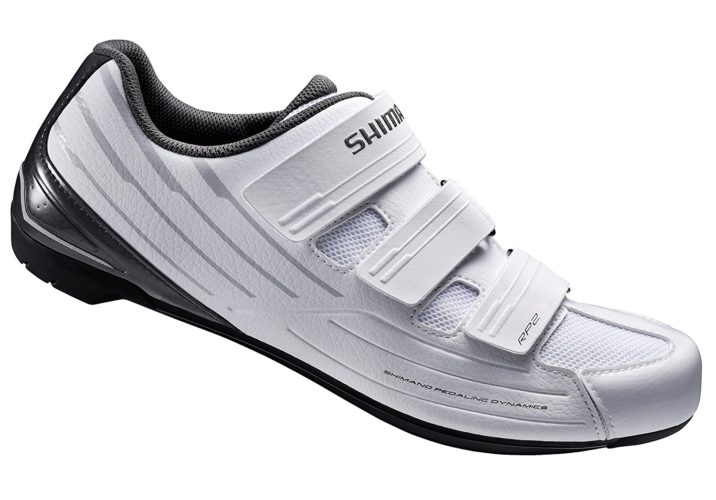 There is a wide variant in the specific make of any particular cycling shoe, depending on the type of riding it is designed for; however, these shoes are all meant to allow the rider to pedal with greater power and efficiency while mitigating a rider’s overall fatigue.
There is a wide variant in the specific make of any particular cycling shoe, depending on the type of riding it is designed for; however, these shoes are all meant to allow the rider to pedal with greater power and efficiency while mitigating a rider’s overall fatigue.
Indoor Cycling Shoes Features & Benefits
Shoes designed for indoor cycling will benefit the user in several ways that may not be evident at first. These shoes are made specifically for the kind of environments that are typical of spin classes and gymnasiums and provide exceptional support and security while you’re engaged in a long-duration ride. Here are a few of the defining features and benefits that outline why you should wear indoor cycling shoes.
● Pedal Support
Indoor cycling shoes feature a rigid upper and a hard sole. The rider’s foot is meant to fit snuggly without any slide within the shoe to enable the most efficient power transfer between pedal strokes. Unlike many outdoor cycling shoes, which feature a semi-flexible sole, indoor cycling shoes benefit the stationary rider with a solid construct, providing maximum support and stability for a rider’s foot.
● Breathability
 Unlike outdoor cycling, there are no natural elements or obstacles to contend with in the gym or the comfort of your own home. Therefore, the paramount concern of an indoor cycling shoe is with regards to its breathability.
Unlike outdoor cycling, there are no natural elements or obstacles to contend with in the gym or the comfort of your own home. Therefore, the paramount concern of an indoor cycling shoe is with regards to its breathability.
Indoor cycling shoes are designed to feature the maximum amount of structural support, sole rigidity, and material breathability. Ensuring adequate air flow and perspiration diffusion while cycling requires specific design features, as opposed to that of outdoor shoes.
● Slip-Resistance
Outdoor cycling shoes are designed to transition from one’s bike onto the sidewalk or soil. Indoor cycling shoes have only one terrain shift—from the bike to the gym floor. To keep users from slipping and sliding around, indoor cycling shoes are often designed specifically to provide excellent grip on smooth tile surfaces and solid wood floors without scratching or scuffing the flooring material.
● Body Alignment
 Indoor cycling entails a rider to remain in a single location while pedaling for an extended period of time. Unlike outdoor cycling, this does not necessitate quite as much give and take in a riders footing, which is why indoor cycling shoes are made for the maximum alignment support.
Indoor cycling entails a rider to remain in a single location while pedaling for an extended period of time. Unlike outdoor cycling, this does not necessitate quite as much give and take in a riders footing, which is why indoor cycling shoes are made for the maximum alignment support.
These shoes ensure that riders do not place undue stress and exertion onto joints muscles and tendons while engaged in prolonged cycling.
● Up-Stroke Pedal Power
Like all connective cycling shoes, indoor cycling shoes’ biggest benefit is the added power in a rider’s up-pedal-stroke. With flat pedals, a rider has no ability to use their up-stroke for pedaling power. The power and energy efficiency that one gains from connective pedal footwear is one of the biggest benefits regarding why you should wear indoor cycling shoes.
Please feel free to leave comments and questions.
